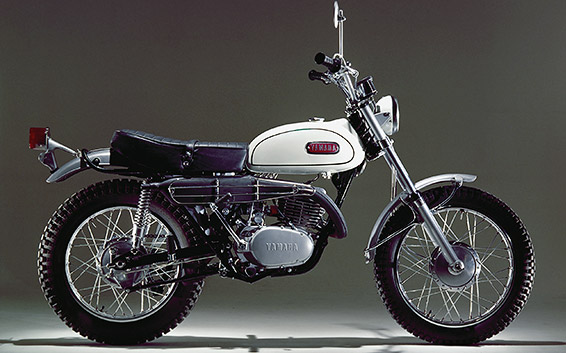Development of the 250 cc Yamaha Trail 250DT1, which debuted on the market in March 1968, began in the US in the latter part of the 1960s.
Development was initiated after receiving information from a local salesperson who handled the Denver, Colorado area. He said that, in Denver, road sports bikes did not sell very well, but what was gaining in popularity were models that could be freely ridden not only on public roads, but also through meadows and in the mountains. He suggested that Yamaha try building that type of motorcycle.
The manager in charge of development and testing at Yamaha’s headquarters who heard this suggestion was puzzled by the idea of a new type of motorcycle that would combine the features of both motocross and trial bikes and could be ridden on normal roads and off-road. Looking back, he remarked, “They said that such bikes were already well established in the US, but I just couldn’t picture what was meant by ‘off-road’ or ‘trail’.

At that time, even the concept of an off-road motorcycle was not very clear in Japan. How to use and ride a trail bike was not really understood. At most, a trail bike was considered a commercially available road sports bike modified with an upturned side muffler. With the market launch of the YDS1, kit parts to alter road sports bikes to scrambler specifications were being sold as a matter of course.
Yamaha did, however, have a model on which to base the DT1. It was the YX26, a true motocross bike that had won the All-Japan Motocross Championship in May 1967. Until the YX26, the YDS1 and its 2-cylinder engine had been modified to be used in motocross, but the YX26 was a prototype that was secretly developed solely for motocross. Its technology was also utilized in the development of the DT1, which was to be mass-produced.

When the resulting DT1 was revealed to the US sales staff in October 1967, it was met with an enthusiastic response that far exceeded expectations. At a time when annual sales of off-road bikes were just 4,000 units, the sales division manager enthusiastically predicated that they could sell 20,000 units a year.
And in fact, sales of the DT1 did take off. In the years to follow, families enjoying themselves together on motorcycles became a reality as camping and motocross grew in popularity. The position of trail bikes rose steadily and the Yamaha brand permeated the US on a nationwide basis.
This movement in the US spread to Japan as well. As soon as it was put on sale in March 1968, the new off-road bike that could also be ridden on roads attracted attention as a completely new type of motorcycle, and its popularity exploded. Yamaha-sponsored trail riding courses, which were developed with the launch of the DT1, were also enormously effective. The model became such a major seller, moving at a rate of 500–600 units a month, that it practically created the market for trail bikes, which became a major category of motorcycles.
.










